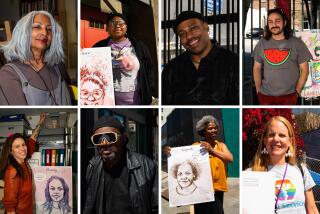Housing Heritage
There are structures-within-the-structure in a holiday show with deep roots at the Skirball Cultural Center and Museum. For âTemporary Quarters: Artists Build for Shelter and Celebration,â three artists were commissioned to create installations inside the Skirball gallery, inspired by the autumnal Jewish festival of Sukkot, when a booth is built outside oneâs house.
These âtemporary quarters,â known as sukkahs, stand as a sober reminder of the forced nomadic state of the Jewish people over history. But, as the exhibition title suggests, there is also a bold celebratory air about them.
Themes of solidarity and bonds of family and spirituality are contained in these gathering places, as well as the exhibitionâs stated expressions of âshelter, hospitality and thanksgiving.â Visitors are invited to touch the art.
The most memorable, and also most minimal, piece here is âTabernacleâ by artist Sam Erenberg, a painter, installation and performance artist who often investigates the interrelationship of space and light. Those artistic interests are combined here with a sense of religious and cultural inquiry.
âTabernacleâ has four walls, two of them shortened to allow for an opening, and two more walls inside, suggesting a cubicle within the cubicle. With this design, Erenberg has created a shrine-like structure functioning both as an enveloped space and a smooth interface to the outside. Elements of the outside, and nature, specifically, are alluded to in outer walls painted with red, swirling patterns that hint at water and clouds.
Significantly, there are no doors, only passages. Open, airy and without a roof, the structure is true to the portable, temporary nature of the sukkah, as a time-bound, personal sanctuary.
Whereas Erenbergâs structure is, more or less, an enclosed refuge, Therman Statomâs installation, âTo Dwell in a Glass House,â is wide open. A glass sculptor and the one non-Jewish artist in the show, Statom has created a three-walled structure from large glass bricks, some transparent and some frosted or etched with imagery of plant life. Drawings of fruits and plants color the atmosphere with an air of harvest, and silver fronds suspended from the ceiling lend a surreal quality of a garden pagoda.
For her part, Marlene Zimmerman sought input from the outside world--and that became part of the art-making in her âJoyful Vision: An American Sukkah.â Sending out appeals through the Internet and newspaper ads, Zimmerman, who describes herself as a âmodern folk artist,â culled information about sukkahs from around the country and has created a composite portrait of this venerable tradition.
A three-walled hut, blanketed by twigs on the roof, serves as an amiable roost in which to study her casual research, with photographs and testimonies gathered into books. Zimmerman has painted several of the photographs on the back wall into a tapestry of vignettes, painted in a folksy manner. Her self-investigative entity basks in the tradition of sukkahs, American-style.
Through these three diverse pieces, the Skirball exhibit is a good showcase of art dealing with a cultural and religious heritage. For those outside the faith, the installations represent well-considered art, with an educational undertone.
BE THERE
âTemporary Quarters: Artists Build for Shelter and Celebration,â at Skirball Cultural Center and Museum, 2701 Sepulveda Blvd., through Jan. 4. Tuesday-Saturday, noon-5 p.m.; Sunday, 11 a.m.-5 p.m. (310) 440-4500.
More to Read
The biggest entertainment stories
Get our big stories about Hollywood, film, television, music, arts, culture and more right in your inbox as soon as they publish.
You may occasionally receive promotional content from the Los Angeles Times.










